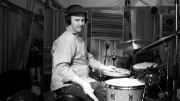“Where is here?” To Winnipeggers it is a query that haunts our collective psyche. It is forever glued to the dashboard of our mind, taunting us like a bouncing bobblehead of blight. What is this place, this “Winnipeg?” Does it even exist at all? Why are we even sticking around long enough to try and figure it out anyway?
It is these questions — of place, of self and of the intersections in-between — that have increasingly defined the work of local artists over the last couple decades. And perhaps nowhere is this more apparent than in the work produced by the Winnipeg Film Group. Now in it’s 35th year, the venerable Arts organization has enabled countless local filmmakers in their exploration of “here.” As Matthew Rankin, a filmmaker long associated with the Film Group, explained, opportunity is rife.
“Winnipeg isn’t a place like New York or Paris. It hasn’t been fabled in story or song,” he said. “So I think it’s still sort of exotic in that respect, it’s still a territory that has yet to be defined. And I think that inspires a lot of filmmakers to speak for it.”
The Film Group’s latest work again attempts to “speak” for Winnipeg, but in an entirely different medium — the printed page. PLACE is a just-released collection of critical and biographic essays on 13 local filmmakers authored by 13 different writers. It is, depending on your interpretation, either a retrospective of the Film Group’s three-plus decades of filmic efforts to define “here,” or it is — as the title hints — perhaps even an attempt in and of itself.
“I know I am biased, but this book is amazing! Not only the content [ . . . ] but what it represents,” elaborated Monica Lowe, the Film Group’s distributor and managing editor of the book. “[It is] a rich history of filmmakers creating work from one city in the middle of Canada. Nothing like it has been written or compiled before, and we are ecstatic we were able to pull it off.”
Assembling 13 distinct filmmakers under the singular banner of “place” might, at first, seem a heady enterprise. Certainly, not every local filmmaker’s oeuvre speak overtly of Winnipeg. But spend any significant amount of time with their films, or in the city itself, and you will begin to realize the inevitability that surroundings and personal narratives bleed into one another.
“Whenever I’m back [in Winnipeg] I feel like I’m in this bizarre dream state,” said Sol Nagler, who contributed an essay on Jeff Erbach, and is currently professor of film production at the Nova Scotia College of Art and Design. He elaborated, “I think once you reach a certain sense of familiarity in something that is so isolated, everything becomes an extension of your own consciousness. In some sense, we’re all living in our own solitary dream worlds in Winnipeg.”
Ah, yes, the inescapable Winnipeg dream-state. It is a not-uncommon belief that the Winnipeg Film Group catalog consists mostly of variations on that single theme. On the twenty-something artiste traipsing labyrinthine apartmentscapes, invoking “weird” and/or “surreal” manners of behavior in high-contrast black-and-white. PLACE doesn’t necessary discredit this.
“Most of the essays in [PLACE] look at patterns in work, and there are patterns that we return to. There’s a certain interest in the weird and the transgressive, as well as a concern for visual style, and formalism,” said Rankin, who penned a filmography of Winston Washington Moxam.
Of course, the oft-cited reason for this eccentric hyper-self-awareness is our city’s geographic and psychological isolation. Indeed, as Nagler pointed out, Winnipeg is an “’island city’ for all intents and purposes” and, as such, “Winnipeggers see themselves as this sort of distinct culture.”
Rankin agrees with the sentiment.
“All this oddball material, anxieties and complexes seem to emerge organically. You step outside of Winnipeg and you see it very differently,” says the filmmaker, who currently resides in Montreal. “Things that seemed normal inside city limits, somehow start to seem very strange. ”
Local filmmaker Sean Garrity, the director of Lucid and Inertia, and subject of an essay by Jonas Chernick, agrees with Rankin about the necessity of being removed from something to interpret it. He said Winnipeg film might have a certain essence, but it’s difficult to ascertain because it permeates us.
“What do I know about the ‘here’ and ‘now?’ I’m in it, so my perspective on the ‘here’ and ‘now’ should be immediately discarded,” Garrity mused. “People will read [PLACE] in five years or something and say ‘Oh, that’s what was going on in Winnipeg at that time.’ So I think it will be valuable in that way.”
Certainly, irrespective of whatever uniquely local peculiarities or insights PLACE may or may not reveal, the collection does undoubtedly represent a genuine marker in time. It is a historicist reading that Rankin echoes.
“[PLACE] is great as a historical tome,” he said. “You know, it speaks to sort of historical narrative to how filmmaking has evolved in Winnipeg, and, in that respect, I think is definitely an important artifact.”
And, in the end, perhaps that is all PLACE needs to be. Indeed, even in its wake, Winnipeggers will undoubtedly continue our near-obsessive compulsion to locate and mythologize our city and ourselves. Films will continue to be made. Dreamers will continue to dream. In fact, it would almost be resoundingly anti-climactic if someone were to actually define “here” at this point. Or if they were to actually source, definitively, the idiosyncrasies and delusions of our condition.
“It could just be the fluoride in the water,” Sol Nagler agreed, offering one such crushing example, perhaps even half-seriously. “I think [Winnipeg] is one of the rare cities that actually puts flouride in the water supply, so, there you go. That could be why.”
Ouch.
PLACE : 13 Essays, 13 Filmmakers, 1 City is available at McNally Robinson Booksellers and through The Winnipeg Film Group.



